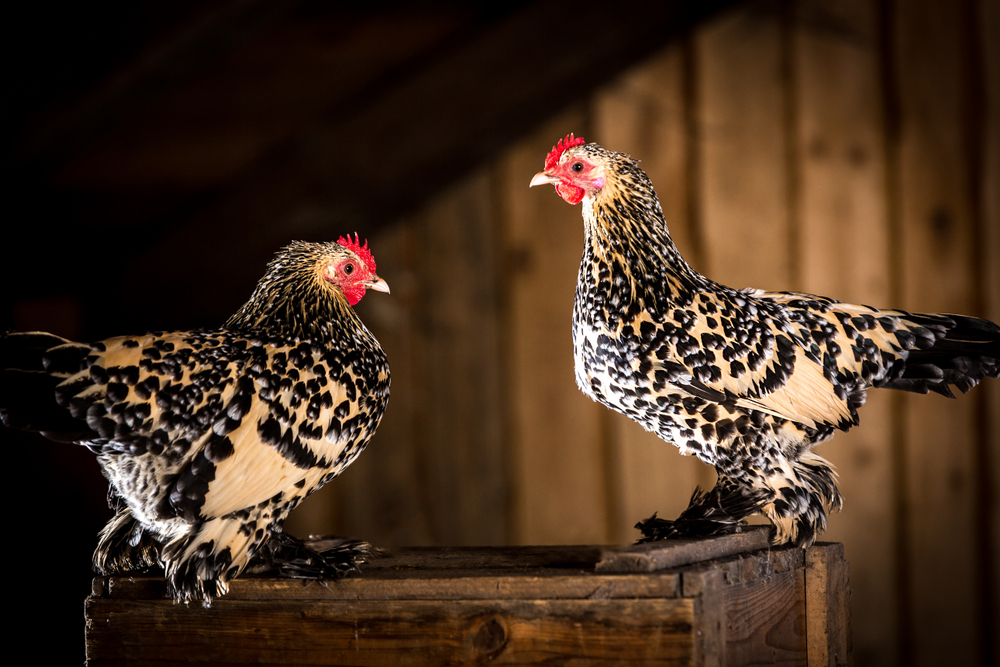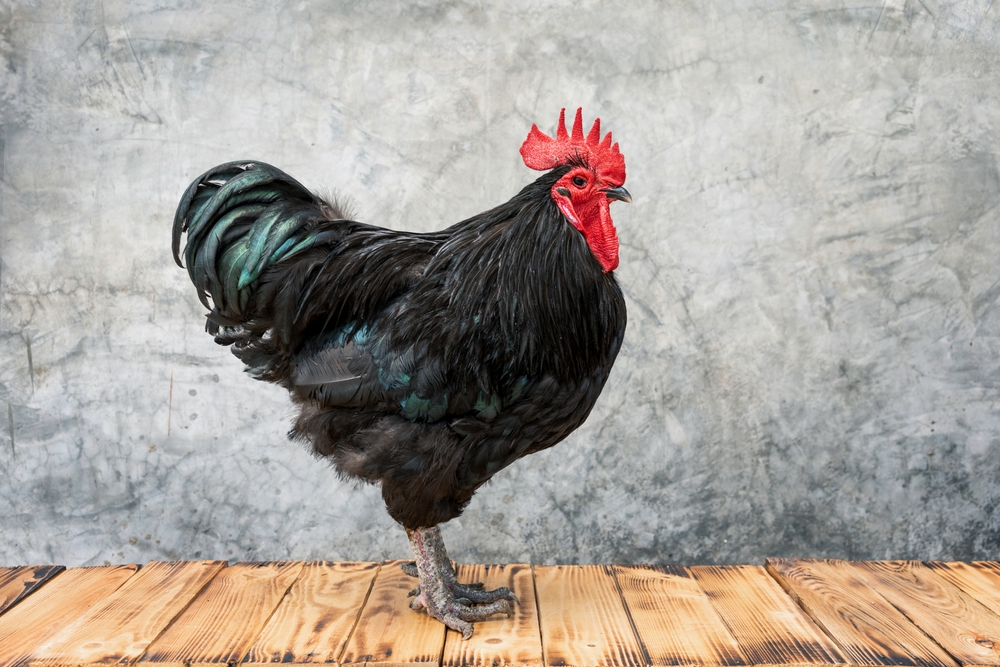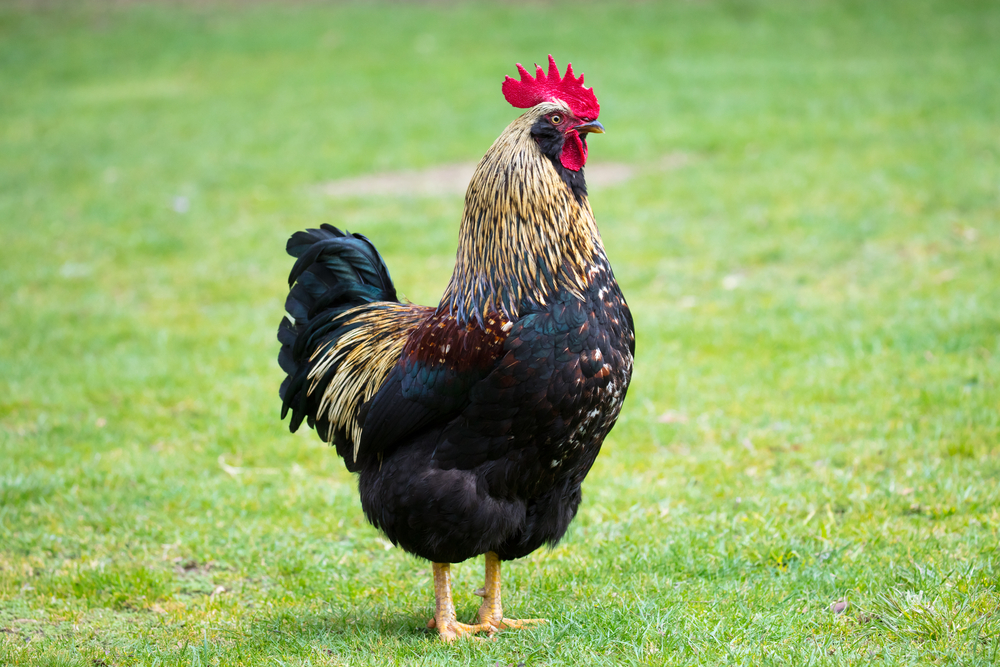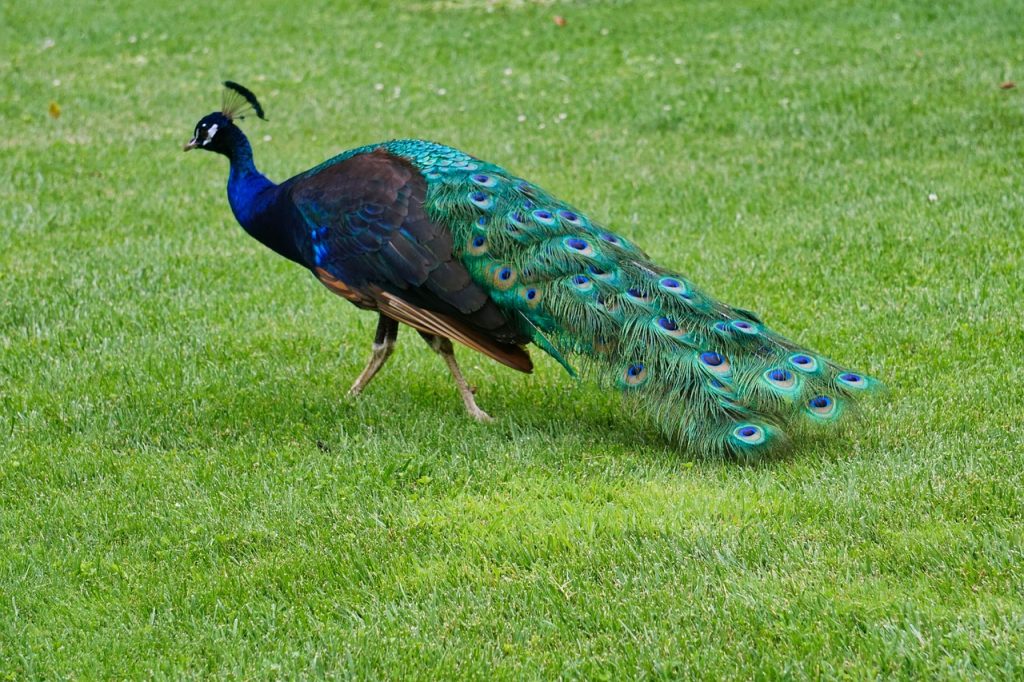The closest relative to the Booted Bantam is the Belgian d’Uccle, which shares its small size, feathered legs, and vulture hocks. The d’Uccle was developed in Belgium and is believed to have been influenced by Booted Bantam genetics, making the two breeds visually and genetically linked.
About
The Booted Bantam, also known as the Dutch Booted Bantam or Sabelpoot, is a true bantam breed—meaning there is no larger counterpart—originating in the Netherlands. It is renowned for its charming appearance, with profuse leg and foot feathering (“boots”) and a long, downward-sloping tail that gives it an elegant, ornamental look.
These small chickens are kept almost exclusively for exhibition and ornamental purposes, as their size and temperament make them ideal for show pens and backyard flocks. Adults weigh only about 600–850 g (1.3–1.9 lbs), with hens being slightly lighter than roosters. They come in a wide variety of colors, including mille fleur, porcelain, white, black, and silver-laced. The mille fleur pattern—golden feathers tipped with black and white—is especially popular for its eye-catching beauty.
Booted Bantams have a single upright comb, red wattles, and a well-proportioned body. Their heavily feathered legs and outer toes give them a unique, “booted” appearance, while their wings are carried low, adding to their ornamental charm.
They are friendly, active, and hardy for their size, though their foot feathering requires clean, dry conditions to prevent damage or infection. They are capable foragers but thrive best in well-managed enclosures. Egg production is modest—hens lay small white eggs, averaging about 100–120 per year.
Because they are gentle and tame, Booted Bantams are often kept by hobbyists, families, and poultry fanciers who value beauty and personality over high productivity.
The Booted Bantam’s scientific classification is Gallus gallus domesticus, and it belongs to the family Phasianidae.
Physical Characteristics
Plumage:
Booted Bantams are known for their profuse feathering, including distinctive “vulture hocks”—long feathers that cover the thighs and curve downward behind the legs. Their body plumage is abundant, soft, and comes in a wide variety of recognized colors, including Mille Fleur (golden with black and white speckling), white, black, blue, and many others. The feathers lie close but have a slightly fluffy appearance due to their volume.
Head and Comb:
The head is small and refined, with a single, upright comb of 5 distinct points. The comb, wattles, and earlobes are bright red, and the beak is short and slightly curved, in horn, slate, or horn-tipped coloring depending on variety. Eyes are round and bright, ranging from reddish-brown to orange.
Body:
The Booted Bantam has a short, compact body with a full breast and a slightly upright stance. The back is short, sloping gently toward the tail, which is full and carried high. The wings are large and carried low, almost touching the hock feathers.
Legs and Feet:
The legs are fully feathered, with soft plumage running down to the outer toes. The breed’s signature vulture hocks give it a distinct, ornate silhouette. Skin color is white, and legs are generally slate or horn-colored, depending on plumage variety.
Tail:
The tail is well-developed, with roosters carrying long, arched sickle feathers and hens having a more compact but still upright tail. Feather quality is fine and soft.
Size:
-
Male Weight: Around 30 oz (850 g)
-
Female Weight: Around 26 oz (740 g)
Sexual Dimorphism:
Males are slightly larger with longer tail sickles, more pointed hackle and saddle feathers, and a more upright carriage. Females have a rounder body shape and shorter tail feathers.
Booted Bantams’ combination of ornamental feathering, compact build, and variety of color patterns makes them one of the most striking and easily recognized true bantam breeds.
Reproduction
Mating Behavior:
Booted Bantams are true bantams (no larger counterpart) and breed readily in both confined and free-range conditions. Roosters are attentive to hens, often performing tidbitting—clucking and offering food—before mating. Due to their light weight and small size, mating is usually gentle and successful without the need for intervention.
Breeding Season:
Capable of breeding year-round in mild climates, Booted Bantams are most productive in spring and summer when daylight hours are longer. In colder climates, supplemental lighting can maintain breeding activity through winter.
Egg Laying:
While primarily kept for ornamental purposes, Booted Bantams are moderate layers.
-
Annual Output: Around 90 to 120 small eggs per year.
-
Egg Color: Cream to pale brown.
-
Egg Size: Small.
Broodiness and Incubation:
-
Booted Bantam hens are noted for strong broodiness and make excellent, attentive mothers.
-
They are capable of hatching their own eggs and even those of other poultry species.
-
Incubation Period: Approximately 21 days.
-
Hens maintain excellent nest hygiene and frequently turn the eggs.
Chicks:
-
Appearance at Hatch: Fluffy, with down color varying according to variety; Mille Fleur chicks often have golden or buff tones with dark markings.
-
Self-Sufficiency: Chicks are active soon after hatching and begin feeding within hours.
-
Growth Rate: Moderate, with full feathering developing early due to the breed’s naturally heavy plumage.
Maturity:
Roosters typically reach sexual maturity at 5 to 6 months, while hens begin laying at around 6 months.
Booted Bantams’ combination of high fertility, strong maternal instincts, and adaptability makes them a reliable choice for breeders who value both appearance and natural reproduction ability.
Lifespan
Lifespan in the Wild/Farm Setting:
As a domesticated true bantam breed, Booted Bantams are typically kept in managed environments. In well-cared-for backyard or hobby farm flocks, they generally live 5 to 7 years. Their small size and light weight make them less prone to leg and joint issues common in heavier breeds.
Lifespan in Optimal Conditions:
With excellent nutrition, predator protection, and regular veterinary care, Booted Bantams can live significantly longer.
-
Average Maximum Lifespan: 8 to 10 years
-
Exceptional cases: 10+ years, especially for birds kept primarily as ornamental pets rather than for production.
Threats to Longevity:
-
Predation: Due to their small size, they are highly vulnerable to hawks, owls, foxes, cats, and dogs in free-range systems.
-
Feather Maintenance Issues: Their heavily feathered legs can collect mud, snow, or debris, leading to discomfort or leg irritation if not managed.
-
Parasites and Disease: Susceptible to external parasites such as lice and mites, and to common poultry diseases like Marek’s disease or respiratory infections.
-
Environmental Stress: Wet or muddy conditions can damage plumage and lead to leg or foot problems.
Booted Bantams are hardy for their size, and with clean housing, balanced feeding, and protection from predators, they can live a long and healthy life, often well beyond the average for many production-focused chicken breeds.
Eating Habits
Diet:
Booted Bantams are omnivorous foragers, thriving on a combination of commercial poultry feed and naturally foraged foods.
-
Primary Feed: High-quality layer pellets or mash containing 16–18% protein, calcium for eggshell strength, and essential vitamins.
-
Foraged Foods: Insects, worms, seeds, grass, and small invertebrates located while scratching through soil and leaf litter.
-
Treats and Supplements: Grains (wheat, oats, cracked corn), leafy greens, vegetable scraps, grit for digestion, and oyster shell or limestone for calcium.
Feeding Behavior:
-
Active and curious, Booted Bantams spend much of the day scratching and pecking for food.
-
They are light-footed and adept at accessing small spaces to find hidden insects and seeds.
-
They require constant access to fresh, clean water, especially in hot weather.
Foraging Times:
-
Most active during morning and late afternoon foraging periods.
-
In the heat of the day, they tend to rest or dust-bathe before resuming feeding.
Adaptations for Feeding:
-
Their small body size and nimbleness allow them to forage efficiently in both confined runs and free-range settings.
-
Strong beaks are suited to breaking seeds and dislodging insects from grass and soil.
Captive Diet Management:
-
A diet rich in balanced poultry feed, supplemented with fresh greens and insects, maintains health and egg production.
-
Over-supplementing with scratch grains can cause excess weight gain and reduced egg-laying.
Booted Bantams’ active foraging habits, adaptability to small spaces, and efficient use of feed make them well-suited for ornamental and backyard flocks where both beauty and utility are valued.
Uniqueness
True Bantam Status:
The Booted Bantam is a true bantam, meaning it has no larger counterpart breed. Its small size and ornamental qualities have been preserved for centuries, making it one of the oldest pure bantam breeds in Europe.
Vulture Hocks and Leg Feathering:
Its most distinctive feature is the profuse leg feathering and dramatic vulture hocks—long, curved feathers that extend down and behind the hocks. This extravagant plumage gives the breed its elegant and showy appearance, distinguishing it from most other bantam varieties.
Wide Variety of Color Patterns:
Booted Bantams are bred in numerous recognized colors, with Mille Fleur (golden with black and white speckling) being the most famous. Other varieties include porcelain, black, white, mottled, and lavender, offering a wide range of visual appeal for poultry enthusiasts.
Ornamental Heritage:
Originating in the Netherlands and documented as far back as the 1600s, Booted Bantams were historically kept as ornamental courtyard birds for nobility and wealthy households. Their purpose has always been aesthetic rather than commercial.
Calm and Companionable Nature:
They are known for their gentle, friendly temperament, making them popular as pets for children and suitable for small garden flocks. Their small size makes them less damaging to garden spaces compared to larger chicken breeds.
Show Bird Popularity:
Because of their striking feathering and variety of colors, Booted Bantams are a mainstay of poultry exhibitions. Breeding for perfect feather condition and symmetry in vulture hocks is a hallmark of competitive showing.
The Booted Bantam’s historic pedigree, ornate feathering, and gentle disposition make it one of the most admired and collectible true bantam breeds in the world.
Be the First to Share Photos of This Species.
FAQ’s
1. What is the closest species to the Booted Bantam?
2. How does the Booted Bantam compare to other chickens?
The Booted Bantam stands out for its:
-
True bantam status, with no large counterpart.
-
Extensive leg feathering and vulture hocks, seen in very few breeds.
-
Primary ornamental purpose, unlike most chickens bred for eggs or meat.
-
Wide variety of recognized plumage patterns, with Mille Fleur being especially popular.
Compared to utility breeds, Booted Bantams lay fewer eggs but excel in beauty, temperament, and suitability for small gardens or exhibition.
3. What national parks provide the best chances to see a Booted Bantam?
As an ornamental domesticated breed, Booted Bantams are not found in the wild. However, they can be seen in heritage farms, agricultural fairs, and living history museums that preserve rare and historic poultry breeds, such as:
-
Aviodrome Heritage Farm (Netherlands)
-
Dutch Open Air Museum – Arnhem (Netherlands)
-
Beamish Open Air Museum (United Kingdom)
-
Old Sturbridge Village (Massachusetts, USA)
-
Sovereign Hill (Victoria, Australia)
These venues often keep Booted Bantams as part of historical livestock displays rather than for production purposes.






































































